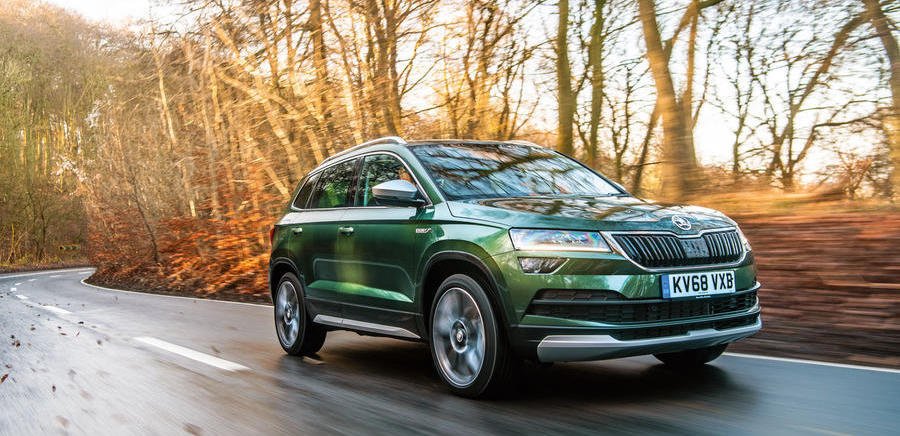What's in a name? We all loved the Yeti, even though it looked insane and had an odd moniker. The Karoq's name is odd, too, but the car beneath the badge is entirely and in some instances delightfully conventional. Larger than the Yeti both inside and out, the Karoq was created with practicality as its main brief – so it retained the smart touches and versatility that made its predecessor so popular, if not that standout styling.
There's a good array of engines. The petrol range has consisted of 113bhp 1.0-litre, 148bhp 1.5-litre and 187bhp 2.0-litre units. For diesel, you can pick between a 113bhp 1.6-litre and two 2.0 diesels of 148bhp and 187bhp. You can also seek out a dual-clutch automatic gearbox, while four-wheel drive is available on the 1.5 and 2.0 petrols and the 2.0 diesel models.
There are varying trim levels, too. SE brings 17in alloy wheels, dual-zone climate control, front and rear electric windows and an 8.0in touchscreen that features smartphone mirroring. SE Technology adds adaptive cruise control and front and rear parking sensors, while SE L has a dedicated built-in sat-nav. Later Sport Line trim features 19in alloys and sports seats, while top-rung Edition spec adds a wider, 9.2in infotainment screen and a panoramic sunroof.
To drive, the Karoq is a very pleasant thing. It isn't quite as sharp in the handling department as the Seat Ateca, with which it shares a platform, but it's tidier and more agile than its other platform mate, the Volkswagen Tiguan. It comes up trumps for comfort, with a well-judged ride that smooths off all but the harshest bumps in town and is delightfully plush at higher speeds.
The Karoq's greatest asset, however, is its interior. It's smart and beautifully built, and there's loads of room for driver and front passenger, and an excellent driving position.
The car's appeal remains strong as you go further back in it because the rear doors open nice and wide and the rear bench is pretty spacious. If you choose an SE L or Edition, you get a fantastically useful 40/20/40-split folding rear seat – or the option to remove the rear seats entirely to maximise boot space. This system was also available as part of the VarioFlex package on SE and SE Technology models.
The boot isn't the biggest in the class, but it is very well shaped, which means you can carry a useful amount in it. And if you don't choose a car with the VarioFlex seating, your consolation prize is an adjustable boot floor with a hidden space beneath the cover for smaller items.
Prices for used Karoqs start at a decent £15,000. Up the budget to £16,000-£18,000 and you'll find plenty of 2018 cars and 2019 cars. Spend around £19,000-£21,000 on a more recent Karoq.
The boot isn't the biggest in the class, but it is very well shaped, which means you can carry a useful amount in it. And if you don't choose a car with the VarioFlex seating, your consolation prize is an adjustable boot floor with a hidden space beneath the cover for smaller items.
Prices for used Karoqs start at a decent £15,000. Up the budget to £16,000-£18,000 and you'll find plenty of 2018 cars and 2019 cars. Spend around £19,000-£21,000 on a more recent Karoq.
Need to know
The 1.0-litre petrol has a WLTP figure of 43.5mpg but the 1.5-litre petrol is only slightly less, at 41.5mpg, thanks to fuel-saving cylinder-deactivation tech. The 1.6-litre diesel is rated at 49.6mpg but the 148bhp 2.0-litre is slightly better still, at 50.4mpg.
It's possible that a small number of Karoqs built in February 2019 have a cracked left front seat frame. A Skoda dealer will be able to inspect your seat and replace the frame if necessary.
There have been two recalls for the rear head restraints in the Karoq. Your local dealer can tell you if your car needs to have any recall work carried out.
Our pick
Karoq 1.5 TSI 150 SE: We love the pace, refinement and efficiency of the 1.5 petrol and there's a good choice of used ones. Entry-level SE is well equipped, but seek out a car that has the VarioFlex seating option.
Wild card
Karoq 2.0 TSI 190 Sport Line 4x4 DSG: With stylish 19in alloy wheels, Sport Line is near the top of the tree, and paired with the rare and more powerful petrol 2.0 and an auto 'box, it's a bit of a peach.
There are varying trim levels, too. SE brings 17in alloy wheels, dual-zone climate control, front and rear electric windows and an 8.0in touchscreen that features smartphone mirroring. SE Technology adds adaptive cruise control and front and rear parking sensors, while SE L has a dedicated built-in sat-nav. Later Sport Line trim features 19in alloys and sports seats, while top-rung Edition spec adds a wider, 9.2in infotainment screen and a panoramic sunroof.
To drive, the Karoq is a very pleasant thing. It isn’t quite as sharp in the handling department as the Seat Ateca, with which it shares a platform, but it’s tidier and more agile than its other platform mate, the Volkswagen Tiguan. It comes up trumps for comfort, with a well-judged ride that smooths off all but the harshest bumps in town and is delightfully plush at higher speeds.

